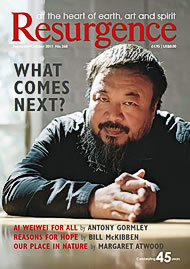This brave book attempts to negotiate some basic questions about the arts, such as: What is art? Is it a recent invention of Western culture? Is it shaped entirely by culture, or is it based on a riverbed common to all humans? And if so, what might that be?
“How odd”, writes Denis Dutton, “that philosophical speculation about art has been inclined toward endless analysis of an infinitesimally small class of cases, prominently featuring Duchamp’s readymades…or…John Cage’s 4'33"… The obsession with accounting for art’s problematic outliers…has left aesthetics ignoring the center of art and its values.”
This centre, Dutton argues, is the art instinct – an evolutionary instinct for both art and beauty founded on the logic of natural selection and sexual (mate) selection. It is part of human nature, with innate tendencies that manifest in widely separated cultures and continue to shape our aesthetic preferences. The arts may seem largely cultural to us, but the underlying instinct that conditions them is not.
To support this theory, Dutton offers a smorgasbord of arguments and evidence. His case for a common aesthetic riverbed formed during human evolution is evocative, but the bootstrapping of evolution itself, and of art and aesthetics, to solely survival and reproductive purposes seems somewhat limiting.
For so much art – in many cultures and time periods – has been motivated by the human instinct for meaning, wisdom, even enlightenment, with very little to do with survival or reproduction. In India, for example, yogic traditions date back to the Indus Valley Civilisation (25th century BCE), and there has been a strong link between the arts and spirituality over centuries. How does one reconcile the ascetic quests and the great art they produced, such as that seen in the caves of Ajanta and Ellora?
Even within the narrow Darwinian framework of evolution, Dutton could have explored related issues, such as mutation and creativity – do mutations occur ‘randomly’, or is there a non-divine ‘creative’ logic to them that flows from the dynamic interconnectedness of living systems in search of new patterns, experiences, and higher functioning? And whether beauty, which forms through relational qualities – balance, harmony, proportion, rhythm – is an organising principle in Nature, and therefore in art.
His suggestion that beauty may be “a mere by-product of a spider’s way of enjoying breakfast” is problematic, because one wonders whether the beauty of the spider’s web is because of the relational qualities of beauty, without which perhaps there might be no web, no breakfast, and no spider either!
Around its central premise of the art instinct, the book covers a range of ideas in art and aesthetic theory and practice, such as a discussion on economist Thorstein Veblen’s ideas about wealth display and the squandering of resources on pointless possessions, of high cost and waste, being intrinsically mixed with our concepts of art and beauty.
There is a useful reminder of Kant’s ideas – that works of art are objects of aesthetic experience, which exist not in the world but in the theatre of the mind, and the influence of his idea of disinterestedness on contemporary aesthetics. Some of his ideas I think may have caused a hollowing of art, the art–craft split, and the banishment of beauty because it was seen, rather limitedly, as something that stoked interest and therefore was better kept away!
There is also an interesting elaboration on kitsch, which Dutton explains is art that attempts to ingratiate itself with the viewer. It is this quality that makes kitsch the opposite of authentic artistic beauty. He writes, “High kitsch demands solemnity and seriousness that is entirely fake and parasitic, and succeeds not by expressing deep emotions but by reminding the viewer of them… It shows nothing new, changes nothing in you, on the contrary it congratulates you for being exactly the refined person you already are.”
This might describe the culture of elite pompousness that has formed amongst art pundits and in the conceptual art movement – postmodern high kitsch, perhaps?
The last chapter usefully reminds us that the greatest works of art are not necessarily the most novel or unusual, but the most personal. Dutton ends with the poignant observation that, “preoccupied as we are with the flashy media and buzzing gizmos of daily experience, we forget how close we remain to the prehistoric women and men who first found beauty in the world. Their blood runs in our veins. Our art instinct is theirs.”
This is a book that causes thinking about the powerful human capacity for art and imaginative experience, which have been the basis for sharing, understanding, learning, creating, and therefore for continued human evolution.






